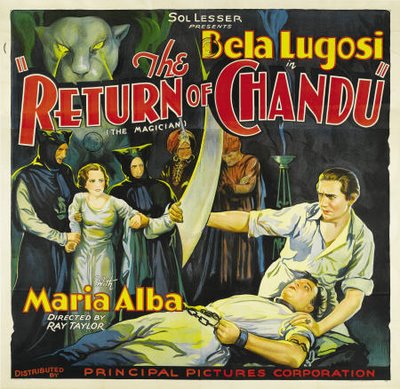
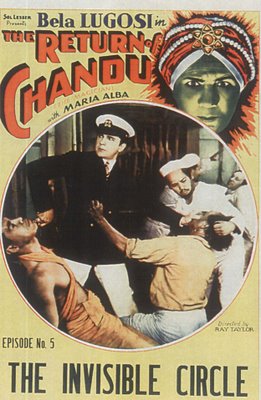
 Lugosi's Heroic Chandu
Lugosi's Heroic ChanduAnyone getting through twelve chapters of The Return Of Chandu should receive merit badges akin to what Boy Scouts awarded for meritorious service. Here is a serial for the hardest core among us. Simpler it would be to ridicule Chandu with a thousand or so words and move on, yet there are values not to be ignored, for this is no ordinary chapter-play. The Return Of Chandu languishes in the Public Domain, an ignominious place where many will say it belongs. I wonder if it was ever properly copyrighted. Produced by Sol Lesser for an outfit called Principal Pictures, Chandu was released as both a serial, and two features. There was also a hybrid version with a full-length story followed by eight weekly chapters. You could thus have Chandu as four different menu selections. Being an independent, it kicked around theatres for twenty or so years after an initial 1934 release, then saw renewed life on stone-age television. A lot of fans came by Chandu sitting cross-legged in front of black-and-white Philcos. Prints were increasingly ragged as negatives wore out and were discarded. Collectors who remembered the glories of Chandu took pains to preserve what was left, videos of wretched quality filling discount bins during the eighties and nineties. VCI’s DVD release appears to have originated from a somewhat battered 35mm original, but it will do because it has to do. No one is likely to initiate (let alone finance) worldwide archival searches for The Return Of Chandu.
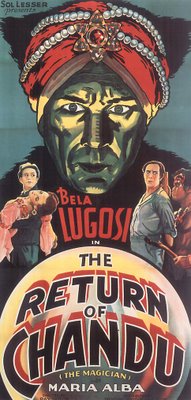
 The major point of interest is, of course, Bela Lugosi. The Return Of Chandu was one time he got to play the hero --- forever in pursuit of those bent on sacrificing his Princess beloved to pagan gods. Serials tended toward a ying-yang structure. Some article or person is bandied back and forth between hero and villain for twelve to fifteen chapters. Variation is difficult to achieve within guidelines so rigid. In the case of Chandu, it is Princess Nadji carried off time and again. Her to--fro between warring camps can be trying, though a truest gift of Chandu is simply observing Lugosi in settings and circumstances unfamiliar to him --- and us. This is a Bela Lugosi Lifestyle Experience --- not a thing to be taken lightly. Measured pacing, particularly in the first half, allows our man to go about a number of routines paralleling his offscreen life. Conversations are prolonged and relaxed. The camera patiently follows as Bela enters and exits a room. One chapter finds him seated in a waterfront barroom, receiving a message of alleged import. For priceless minutes, he works with various props likely part of the actor’s daily routine as well. An ever-present cigar is put aside in favor of a note pad with fountain pen, and for the only time I can recall, we see Lugosi writing in longhand, holding the utensil in a manner I’ve not encountered over all my years observing other's penmanship. Sartorial elegance is maintained by way of crisp white trousers and sport jacket, the occasional turban (always a welcome Lugosi accessory), and a natty yachting outfit topped with an admiral’s cap. Bela radiates confidence here. What a pity to see it snatched away in a subsequent chapters …
The major point of interest is, of course, Bela Lugosi. The Return Of Chandu was one time he got to play the hero --- forever in pursuit of those bent on sacrificing his Princess beloved to pagan gods. Serials tended toward a ying-yang structure. Some article or person is bandied back and forth between hero and villain for twelve to fifteen chapters. Variation is difficult to achieve within guidelines so rigid. In the case of Chandu, it is Princess Nadji carried off time and again. Her to--fro between warring camps can be trying, though a truest gift of Chandu is simply observing Lugosi in settings and circumstances unfamiliar to him --- and us. This is a Bela Lugosi Lifestyle Experience --- not a thing to be taken lightly. Measured pacing, particularly in the first half, allows our man to go about a number of routines paralleling his offscreen life. Conversations are prolonged and relaxed. The camera patiently follows as Bela enters and exits a room. One chapter finds him seated in a waterfront barroom, receiving a message of alleged import. For priceless minutes, he works with various props likely part of the actor’s daily routine as well. An ever-present cigar is put aside in favor of a note pad with fountain pen, and for the only time I can recall, we see Lugosi writing in longhand, holding the utensil in a manner I’ve not encountered over all my years observing other's penmanship. Sartorial elegance is maintained by way of crisp white trousers and sport jacket, the occasional turban (always a welcome Lugosi accessory), and a natty yachting outfit topped with an admiral’s cap. Bela radiates confidence here. What a pity to see it snatched away in a subsequent chapters …

Seven through Twelve relocate to the Island of Lemuria (a more appropriate name might be the Island of Lugubrious). Having been shipwrecked, the cast is brought ashore dripping wet to endure further abductions and discomfort. This is where one really feels for Lugosi. He’s obliged to wear the same grubby shirt for a balance of the show, that in addition to physical exertion required by the script. Bela’s co-stars are similarly put upon. Wilfred Lucas (63) and Clara Kimball Young (44 – looks 64) were silent veterans dating back to Griffith, now overweight and down on their luck as both are shoved about by extras ignorant of how prominent they were in nickelodeon days. Lugosi struggles through fistic brawls I'd not wish on a man twenty years younger, apprehension in cave passages all too convincing. What if the set suddenly gave way and he fell down an ignominious Poverty Row abyss? Maybe such labyrinths provided Lugosi a glimpse into his own future, low-grade product of Return Of Chandu sort providing most of sustenance for a remainder of his career.
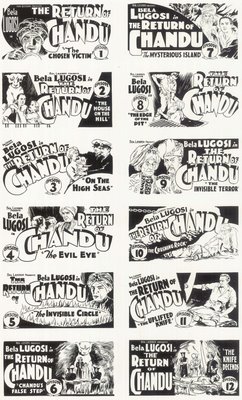
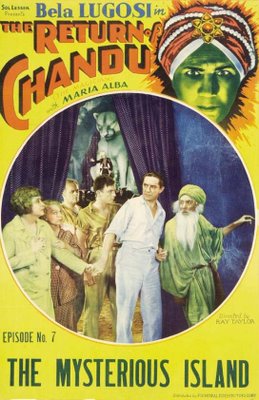

"Educational TV" used to be about the only place you could see really old movies. They ran silents when no one else would. Sometimes there were documentary programs devoted to genres people had forgotten. One of these was They Went Thataway, a ten-part series produced in 1969/70 about "B" westerns hosted by Jon Tuska, a writer who, among other things, gave us the definitive history of Mascot Pictures. The theme for They Went Thataway was a composition by Nem Harkins called S.O.S. It was another among hundreds of short musical bursts designed to make a "B" viewer’s heart beat faster, but I never forgot S.O.S. as weekly opener to They Went Thataway. S.O.S. turns up several times in The Return Of Chandu, along with other agitatos like Nervousness and The Menacing Foe. Their composers never took home Oscars, but for anyone who has watched serials and westerns, these accompaniments have a mesmerizing effect. Maybe it’s harsh recording, or the primitive arrangements --- much of Chandu's music was borrowed from radio, or rented through the Abe Meyer Synchronization Service, always ready to supply an appropriate theme for producers lacking resources to hire an orchestra. The Kalmus Library was another provider of musical mood to low-budget enterprises. Chandu was one of the very first sound serials to feature near continuous accompaniment. Later Universal and Republics had slicker scores, but few with the raw energy of these cobbled together backgrounds.
Your best bet for quality with The Return Of Chandu is the VCI disc, available HERE. A great place to go for updates on serial releases is In The Balcony (HERE), which features reviews and a discussion group as well. Laughing Gravy is the moderator, and his site is a continuous joy to read.
2 Comments:
this blog isn't my first stop on the web each day....but it's easily the most enjoyable. today's entry, as always, top notch. just wondering...you use the words "sartorial elegance" when describing lugosi's daily routine.
try as i might, i can't really think of one single 'star' these days that'd qualify for that compliment. (unless, of course, we could stretch the definition of "sartorial" to include the latest tattoo.)
(ok, ok: we'd also have to stretch "elegance" to make that work, wouldn't we.) (*sigh*)
Well as usual I cannot fault your facts and your insights range from "I'm not sure I agree but it's an interesting point" to the “absolutely brilliant" so it's obvious that I feel your comment on THE RETURN OF CHANDU fall into the former camp. I actually find this serial much less tedious than a slicker Republic effort such as THE MASKED MARVEL which has a very "unflavored tapioca" quality to it. The earlier serials with their "everything but the kitchen sink" approach is a lot more fun. Even something as dire as THE AMAZING EXPLOITS OF THE CLUTCHING HAND has its atmospheric moments.
THE RETURN OF CHANDU benefits from its source. Anyone who has listened to any of the radio shows (what's a really good source for these?) will notice that they are total malarkey and tons of fun. The anything goes no matter how outlandish quality was best captured in the earlier, big-budget Fox film CHANDU THE MAGICIAN. Any lawsuits related to the similarities between CHANDU and the much later MANDRAKE THE MAGICIAN?
Still I fear I am alone in defending this serial. Watch a chapter at a time on rainy nights and see if it doesn't grow on you.
Post a Comment
<< Home